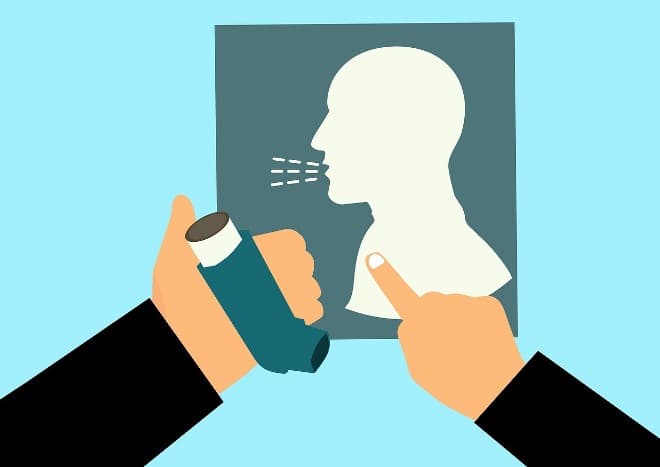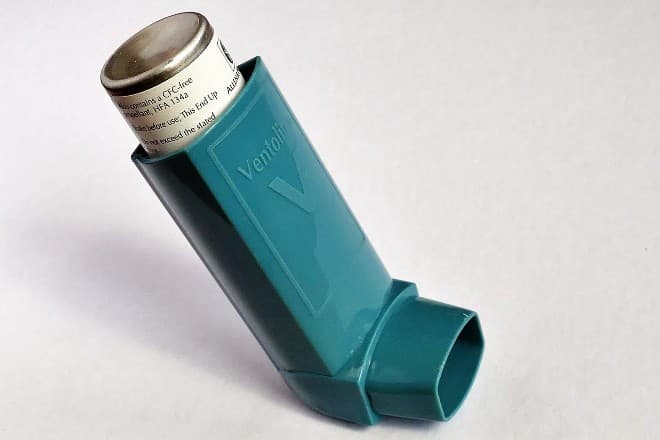
Photo Credit: by pixabay
Asthma is an inflammatory condition which causes temporary obstruction of airflow to the lungs thereby causing difficulty in breathing. In asthma patients, the airway (the tubes that carry air into the lungs) are highly sensitive to specific triggers that initiate an inflammatory process. Apart from inflammation in the airway, other changes that occur include tightening of the airways and excess mucus productions. Signs and symptoms of asthma include one or more of the following: wheezing (noisy breathing), chest tightness, coughing, and shortness of breath. Asthma is common in children and adults alike, and may also affect pets such as cats and dog. According to the CDC, patients with moderate to severe asthma have a higher risk of getting very sick from covid-19, if exposed.
Causes of asthma

Photo Credit: Image from Lung.ca
The root cause of asthma is a complex interaction between environmental and genetic influences. Certainly, there is a genetic component to the development of asthma. Other risk factors include: smoking or secondary exposure to smoke, presence of other allergies and atopic dermatitis (eczema), obesity, air pollution in the house, outdoors or at workplace.
The main underlying factor that leads to the development of asthma is that the airways of asthmatic patients are excessively reactive to certain allergens or triggers. Common asthma triggers include: exercise, cold air, smog, smoke, hot humid air, scents, emotional upsets, anxiety or stress. The smell of some disinfectants can also trigger an asthmatic attack, especially with the ongoing pandemic.
Treatment and management of asthma
The main goals of asthma management are to control symptoms, prevent future attacks and complications, and lastly to minimize side effects from medications. It is important for asthma patients and their families understand the causes of asthma and in case of specific triggers learn to avoid such triggers where possible. Asthma patients should also learn how to monitor their symptoms at home recording the frequency and severity of cough, chest tightness, difficulty in breathing and the need to use reliever medication. A personalized asthma action plan should be provided in conjunction with an health care provider detailing what steps to take if the condition gets worse and how to adjust medications based on symptoms.
Treatment choices for asthma depend on severity of the disease for example, intermittent, moderate, moderate-severe and severe.
Drugs used for asthma treatment and management belong to 2 major categories: Rescue inhalers and Controller Inhalers. Here is a link to a quick overview of various asthma medications and their prices
Quick reliever inhaler (Rescue Inhaler): The most common quick reliever inhaler is Ventolin, which contains salbutamol also known as albuterol. It is a short acting bronchodilator that works immediately to open up the airways and makes breathing easier. The quick reliever inhaler Ventolin and its equivalents are usually blue is color and so sometimes also called the blue inhaler. Ventolin works for a short term and so should only be used when needed for shortness of breath. If there is ever need to use ventolin for more than 3 times per week or need to use ventolin in the night more than once per week, it is a sign that things are not going well and may need to follow up with the doctor. If you think your blue inhaler is not helping you breath better after using or if your symptoms are standing in the way of your normal exercise or daily routine, it is time to seek further medical attention.
Steroid anti-inflammatory inhaler (Controller Inhaler): There are a number of steroid inhalers available but the most commonly prescribed is the Flovent. Flovent contains the steroid fluticasone, which works by reducing inflammation on the airways. The Flovent metered dose inhaler comes as 125mcg/dose and 250mcg/dose to be used twice daily. Flovent inhaler is orange in color and may sometimes be referred to as orange inhaler. The major difference between the orange and blue inhaler is that blue inhaler is a rescue inhaler and so it’s used only when needed while the orange inhaler needs to be used regularly for a period prescribed by the doctor. Regular use of flovent will keep the airway inflammation well managed and thus reduce occurrence of shortness of breath. Other inhaled corticosteroids include the following: budesonide (Pulmicort), ciclesonide (Alvesco), fluticasone furoate (Arnuity), mometasone (Asmanex), beclomethasone (Qvar).
Long-acting bronchodilator (LABA): Long-acting bronchodilators are usually used in combination with a steroid inhaler for cases that do not improve with steroids inhalers only. For example, Advair (fluticasone and salmeterol), Zenhale (mometasone and formoterol), Breo Elipta (fluticasone and vilanterol) and symbicort (budesonide and formoterol).
Other drugs such as montelukast (leukotriene receptor antagonist), Spiriva (long acting muscarinic antagonists), or even prednisone (oral corticosteroids) can also be used to control symptoms of asthma.
Flovent inhalers for pets
Just as in humans, Flovent inhaler may sometimes be prescribed by Veterinarians in pets (cats and dog) to control inflammation in the lungs due to asthma or bronchitis. Symptoms in pets are similar such as wheezing, coughing, and difficulty breathing. For best results, inhalers should be administered with the help of a spacer device AeroKat for cats and AeroDawg for dogs. Before administering an inhaler via the AeroKat or AeroDawg, slowing introduce the device to your pet to get them accustomed with the device before the actual drug administration. Shake the inhaler before use. Load a puff of the medication in the delivery chamber and the fit snugly on the pets face. It is important to ensure that the face mask of the aerochamber fits snugly on the pet’s face to ensure maximum intake of the drug. Allow the pet to breathe 7-10 times before removing the chamber. The main advantage of inhaled corticosteroid versus the oral form is that medication can be delivered directly to the lungs, where it is needed and thus avoiding side effects on other parts of the body.
How to use metered-dose inhalers for best results
There are many different types of asthma medications available in various devices. The most common inhaler device is the Metered Dose Inhalers (MDI). Other types of inhaler devices include Dry Powder Inhalers such as Ellipta, Diskus, Turbohalers and soft mist inhalers devices like Respimat.

Photo Credit: by Pixabay
MDI can be used with a spacer device such as an aerochamber in people that may find it hard to coordinate dose actuation and inhalation such as in children, pets (cats and dogs) or in older adults.
These video links demonstrates how to use a MDI with and without a spacer.
How to use a MDI with spacer
How to use a MDI without spacer
• Take the cap off the mouthpiece and shake the inhaler for 5 seconds.
• Hold the inhaler upright with your finger on the top of the canister and your thumb holding the bottom of the inhaler.
• Breathe out a normal breath and close your lips around the mouthpiece, or hold the mouthpiece 1 to 2 inches (4 cm) in front of your mouth.
• As you start to inhale the next breath, press down on the canister.
• Keep inhaling deeply and slowly through your mouth.
• When your lungs are full, hold your breath for 5 to 10 seconds to keep the medicine in your lungs. Then let your breath out.
• If you are supposed to take 2 puffs of your inhaler, wait 15 to 30 seconds before you take the second puff. Shake the inhaler again before the second puff. Put the cap back on the mouthpiece.
• If you use a steroid inhaler, rinse your mouth out with water, gargle, and spit out the water to prevent fungal infections in the mouth.
Signs and symptoms of a serious asthma emergency
If you ever experience any of the following symptoms, Call 911 and keep taking your rescue medication (blue inhaler): struggling for breath, blue rescue inhaler doesn't help, difficulty speaking, can't finish a sentence, sucking in skin above breastbone and between ribs, nostrils flaring out, pale, grey, sweating, blue lips or, nail beds, really tired, lethargic, unconscious (fainted).
###
Bio: Dr. Bolanle Aina is a licensed pharmacist currently practicing in the community/retail sector. She also holds a Master of Science degree and Doctor of philosophy degree in Pharmacy from the University of Manitoba. She is passionate about health information and medical communication to promote healthy living and optimal drug therapy.
Your email address will not be published. Required fields are marked with *.